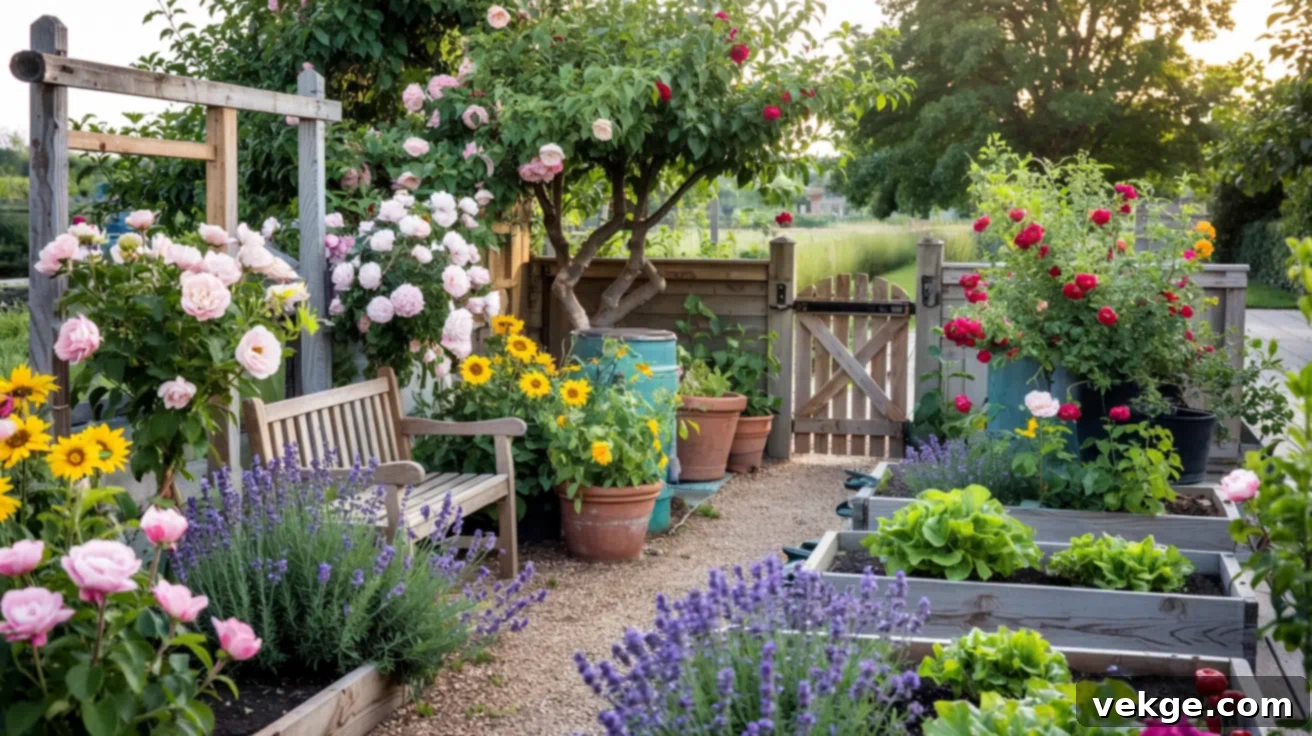Unlock Your Dream Yard: Essential Cottage Garden Layouts for Every Space
Do you ever gaze at your garden and envision a space that truly reflects your personality—a haven that feels lived-in, peaceful, and vibrant with plants you adore? If you’re like many garden enthusiasts, you long for an outdoor sanctuary that embodies charm and natural beauty. This dream is entirely achievable with a cottage garden design. You don’t need an expansive property or an unlimited budget; just a dash of thoughtful planning and your unique personal touch.
In this comprehensive guide, we’ll explore how you can craft your ideal outdoor area using practical cottage garden layout ideas, expert plant selection tips, and simple strategies to get started. Whether you’re a seasoned gardener or a complete beginner, prepare to cultivate a garden that evolves and flourishes alongside you. Let’s embark on this journey together, shaping your dream garden one intentional step at a time.
Understanding the Enchantment of Cottage Garden Design
Cottage gardens are celebrated for their inviting, free-flowing aesthetic that radiates warmth and a sense of history. They embrace a relaxed, organic layout, frequently incorporating winding paths that invite exploration through densely planted, colorful displays. Unlike highly structured formal gardens, cottage gardens encourage plants to intertwine and gently spill over their boundaries, creating a soft, abundant tapestry of life.
These captivating spaces expertly blend a diverse array of flora—from cheerful flowers and fragrant herbs to edible vegetables—all coexisting harmoniously within the same beds. This intermingling creates a rich, multi-layered visual experience that is both beautiful and functional. Natural materials such as aged wood, rustic brick, and weathered stone are commonly used for borders, pathways, and tranquil seating areas, imbuing the garden with an authentic, handcrafted charm that feels deeply rooted and welcoming.
The beauty of a cottage garden lies in its adaptability and forgiving nature. The layout is inherently soft and flexible, allowing for natural growth and evolution. Maintenance typically focuses on seasonal care, encouraging a symbiotic relationship with nature where plants are allowed to thrive in their own unique ways. The result is a simple, vibrant, and utterly welcoming outdoor living space that bursts with life and character.
Strategic Planning for Your Ideal Cottage Garden Layout
Embarking on a cottage garden project, especially from the ground up, requires a thoughtful approach. This section will guide you through the essential steps to shape your garden effectively, from selecting the perfect location to organizing your space and skillfully avoiding common design pitfalls.
Selecting the Perfect Location for Your Cottage Garden
Your garden’s success begins with its location. Spend time observing your yard throughout the day, noting where sunlight falls, where consistent shade provides respite, and how wind patterns affect different areas. Understanding these microclimates is crucial for plant health. Beyond light, good soil is paramount: a rich, loamy, and well-drained earth is ideal, fostering strong root growth and nutrient absorption.
Actively avoid areas that tend to remain waterlogged or experience heavy foot traffic, as these conditions can hinder plant growth and create maintenance challenges. If your existing soil isn’t optimal, don’t despair; consider implementing raised garden beds or using a variety of containers to create ideal growing environments. Furthermore, choose a spot where your garden will be easily visible and accessible—perhaps near a kitchen window, a frequently used patio, or a quiet sitting area. A prominent and sunny location ensures you can fully enjoy your garden’s beauty and tend to its needs with ease, making it an integral part of your home experience.
Dividing Your Garden into Functional Zones
Envision your garden as an extension of your home, an outdoor room with distinct functional areas. Begin by dividing your space into zones, thoughtfully allocating them based on sunlight exposure, shade patterns, and your desired activities for each area. Reserve the sunniest spots for flourishing vegetables and aromatic herbs, which require ample light to thrive. Conversely, designate shadier corners near fences or beneath trees for shade-loving plants like hostas or ferns.
To define these zones and guide movement throughout your garden, incorporate clear pathways. Materials like fine gravel, natural mulch, or charming stepping stones not only delineate planting areas but also enhance the cottage garden aesthetic. Consider integrating a comfortable seating area—perhaps a rustic bench or a cozy bistro set—perfect for reading, relaxing, or enjoying a morning coffee amidst your blooms. Strive for a layout that feels both balanced and practical, ensuring ease of navigation and maintenance. Grouping plants with similar cultural needs (e.g., sun requirements, watering frequency) simplifies care routines while maintaining an organized and visually appealing space.
Sketching Your Cottage Garden Design: From Concept to Blueprint
Before you even think about planting, dedicating time to sketch your garden ideas on paper is invaluable. Your sketch doesn’t need to be a work of art; its purpose is to map out the foundational elements: the shape and size of your planting beds, the routes of your pathways, and the placement of key features like benches, birdbaths, or decorative trellises. Mark areas that receive full sun, partial sun, and full shade to inform your plant selection and placement, ensuring each plant thrives in its optimal environment.
If drawing isn’t your forte, don’t worry. A wealth of free layout templates and garden design apps are available online, offering pre-designed shapes and helpful guides for visualizing plant spacing and overall structure. These templates can act as an excellent starting point, providing inspiration and practical frameworks. A well-thought-out plan now is your best defense against costly and time-consuming mistakes later, allowing you to cultivate your cottage garden with confidence and clarity.
Inspiring Cottage Garden Layout Ideas for Any Space
The beauty of cottage garden design is its versatility; you don’t need a sprawling estate to create a charming, plant-filled sanctuary. These flexible layout styles are adaptable to various garden sizes—whether you have a compact balcony, a medium-sized suburban yard, or a more expansive property—allowing you to maximize your available space with grace and functionality.
1. Border-Only Layout: Maximizing Narrow Spaces
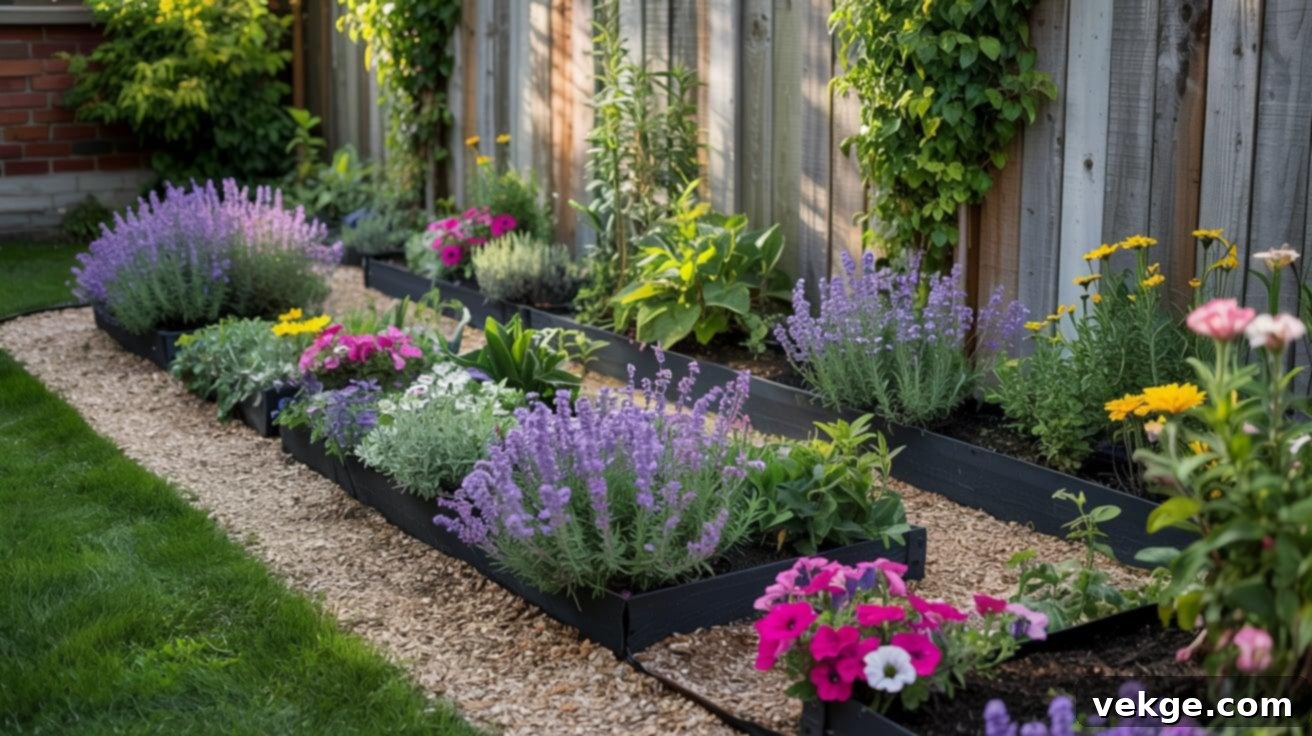
This layout is an excellent choice for challenging areas such as narrow side yards, along fence lines, or in any space with limited depth. The concept involves planting in elongated strips or ribbons along one or two perimeters of your property. To create visual interest and depth, arrange taller plants at the back of the border, gradually layering down to lower-growing varieties at the front. This technique adds vibrant color and rich texture without demanding an entire yard. It’s a fantastic way to incorporate a delightful mix of herbs, perennial flowers, and even compact vegetables. A narrow, meandering path made of permeable materials like gravel or bark mulch can be integrated alongside, providing essential access for maintenance while distinctly defining the planting area and enhancing its cozy, informal appeal.
2. Central Pathway Layout: Balanced and Inviting
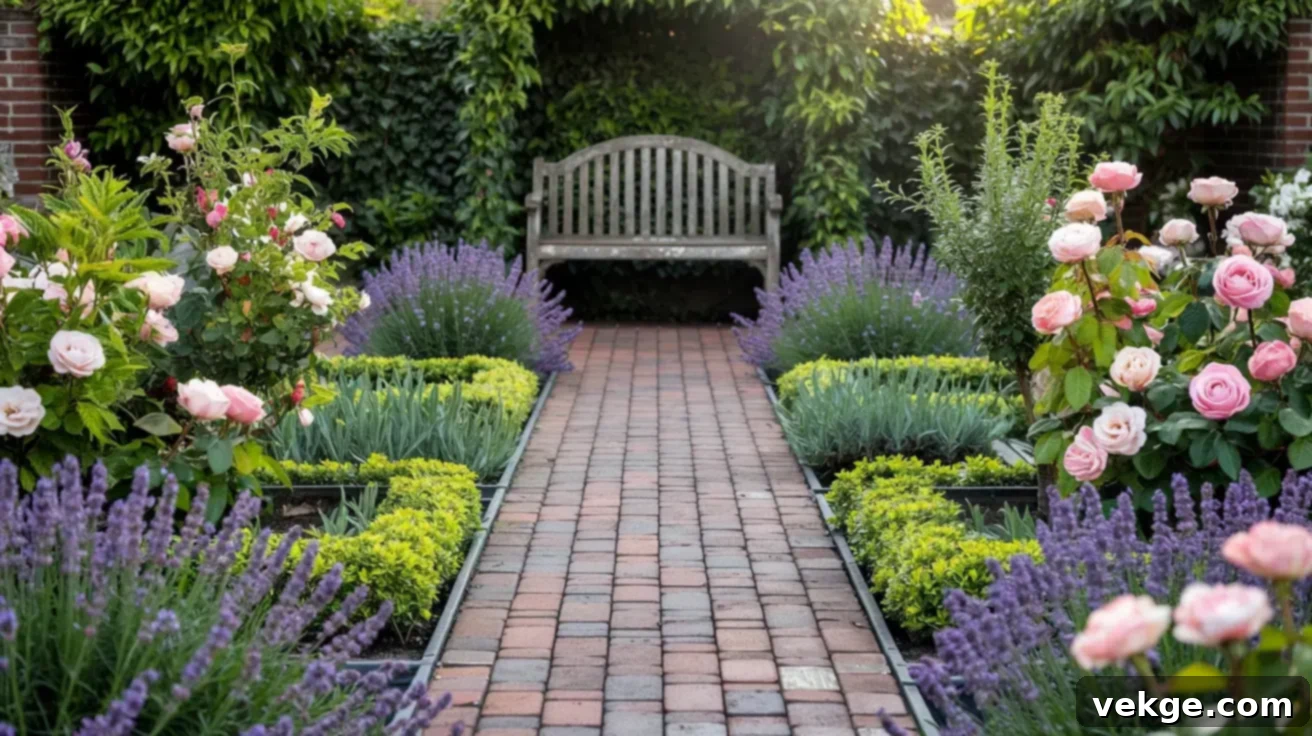
A central pathway design creates a beautifully balanced and symmetrical aesthetic, making it particularly well-suited for welcoming front yards or more traditional garden settings. To implement this layout, establish a prominent path down the middle of your garden space, using charming materials such as classic brick, crushed gravel, or rustic stepping stones. On either side of this central axis, design symmetrical planting beds overflowing with a lush combination of flowering perennials, fragrant herbs, and graceful shrubs. To draw the eye and add a touch of whimsy, place a decorative bench, a captivating birdbath, or a small sculpture at the path’s terminus, creating a charming focal point. This layout strikes a perfect balance: it feels organized and well-defined yet bursts with the natural variety and abundance characteristic of a cottage garden. It also offers effortless access for all your gardening and maintenance tasks.
3. Corner Garden Layout: Utilizing Unused Nooks
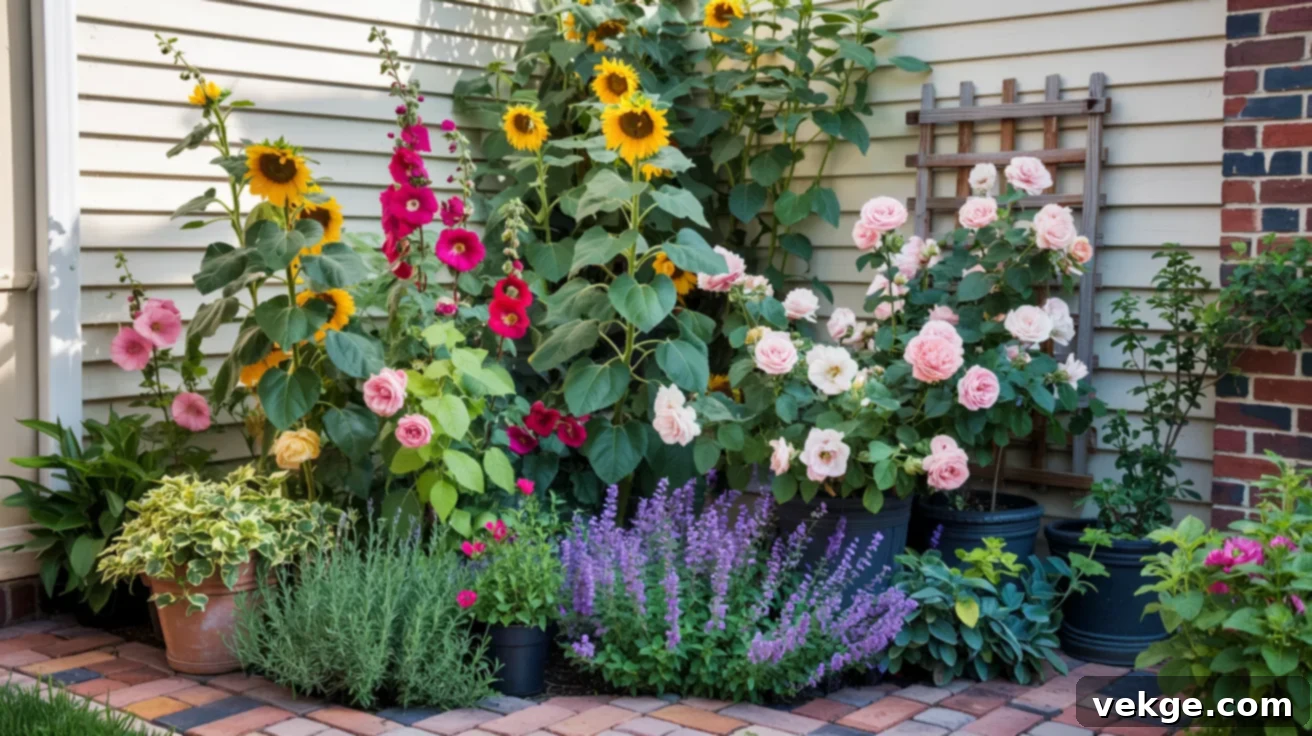
The corner garden layout is an ingenious solution for suburban homes or patio areas that feature often-overlooked or awkward unused corners. Begin by anchoring the design with taller, commanding plants like towering hollyhocks, majestic sunflowers, or slender delphiniums positioned at the back of the corner. From this backdrop, layer progressively downward with medium-height flowering plants, such as foxgloves or daisies, cascading toward the front, and finally, delicate groundcovers to soften the edges. You can further enhance vertical interest by adding a small trellis in the deepest part of the corner, perfect for supporting climbing roses, clematis, or morning glories. This clever layout breathes life and vibrant color into areas that might otherwise remain bare, making it exceptionally effective near fences, garden sheds, or adjacent to a cozy outdoor seating arrangement.
4. Full-Square Layout with Zones: Immersive Garden Worlds
If your property boasts a square or securely fenced yard, this layout offers an immersive way to divide the entire space into distinct, functional zones. Imagine dedicating one section entirely to a riot of colorful flowers, another to a fragrant culinary herb garden, and a third to a bountiful vegetable patch. Clear, well-defined pathways, crafted from gravel, bark, or artfully placed stepping stones, are crucial for separating these sections and guiding visitors through your garden’s different “rooms.” To enhance visual appeal and create a tranquil focal point, consider placing a charming seating area or a soothing water feature—like a small fountain or birdbath—in the center or a secluded back corner. This comprehensive layout provides a feeling of stepping into an entire garden world, making it an ideal choice for larger properties or ambitious backyard transformations, offering both aesthetic beauty and practical utility.
5. Container-Based Layout for Small Spaces: Portable Garden Charm

No traditional yard? No problem! A container-based layout is the perfect solution for renters, urban dwellers, or anyone with a balcony, patio, or small deck. The key to success here is using an artful mix of pots and planters in varying heights, shapes, and materials (terracotta, glazed ceramic, metal, wood) to create dynamic visual interest. Select compact plant varieties that thrive in containers, such as fragrant lavender, creeping thyme, cheerful petunias, miniature roses, and even dwarf fruit trees. Group containers strategically based on their sunlight requirements, ensuring each plant receives its ideal light. To maximize space and add another dimension, incorporate vertical elements like ladder shelves adorned with small pots or elegant hanging planters. This ingenious layout allows you to cultivate the timeless beauty of a cottage garden without ever needing to dig a single hole in the ground, offering flexibility and portable charm.
Crafting Your Ideal Planting Plan for Continuous Beauty
A well-conceived planting plan is the cornerstone of a cottage garden that looks full, vibrant, and perfectly balanced throughout the entire year. To achieve the best results, think in layers, strategically mix different plant types, and meticulously consider both seasonal bloom times and sunlight requirements for each species.
Layer by Height: Tall, Mid-Height, and Ground-Cover Plants
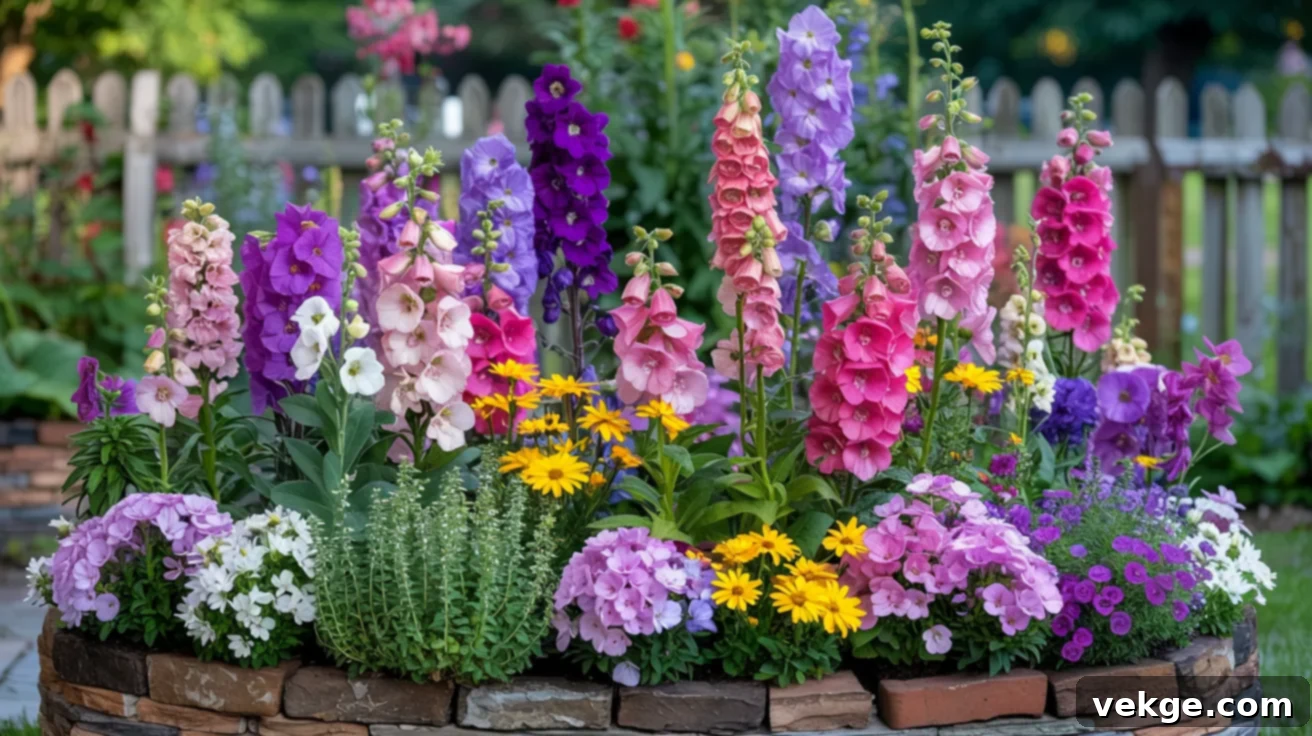
To create a visually rich and accessible garden, employ a tiered planting strategy. Begin by positioning your tallest plants—such as stately hollyhocks, grand delphiniums, or soaring sunflowers—at the very back of your beds if they back onto a wall or fence, or in the center if the beds are viewed from all sides. Next, introduce mid-height plants like elegant foxgloves, cheerful daisies, or vibrant coneflowers. These fill the middle ground, adding significant bulk and color. Finally, complete your layers with low-growing plants, like delicate alyssum, fragrant creeping thyme, or charming sedum, along the edges of your beds to soften borders and prevent bare spots. This tiered approach ensures that all your plants are visible and receive adequate light, while also adding crucial texture and depth to your cottage garden. Moreover, it simplifies maintenance, as shorter plants are less likely to be overshadowed or hidden by their taller counterparts.
Seasonal Planting Strategy: A Symphony of Blooms Year-Round
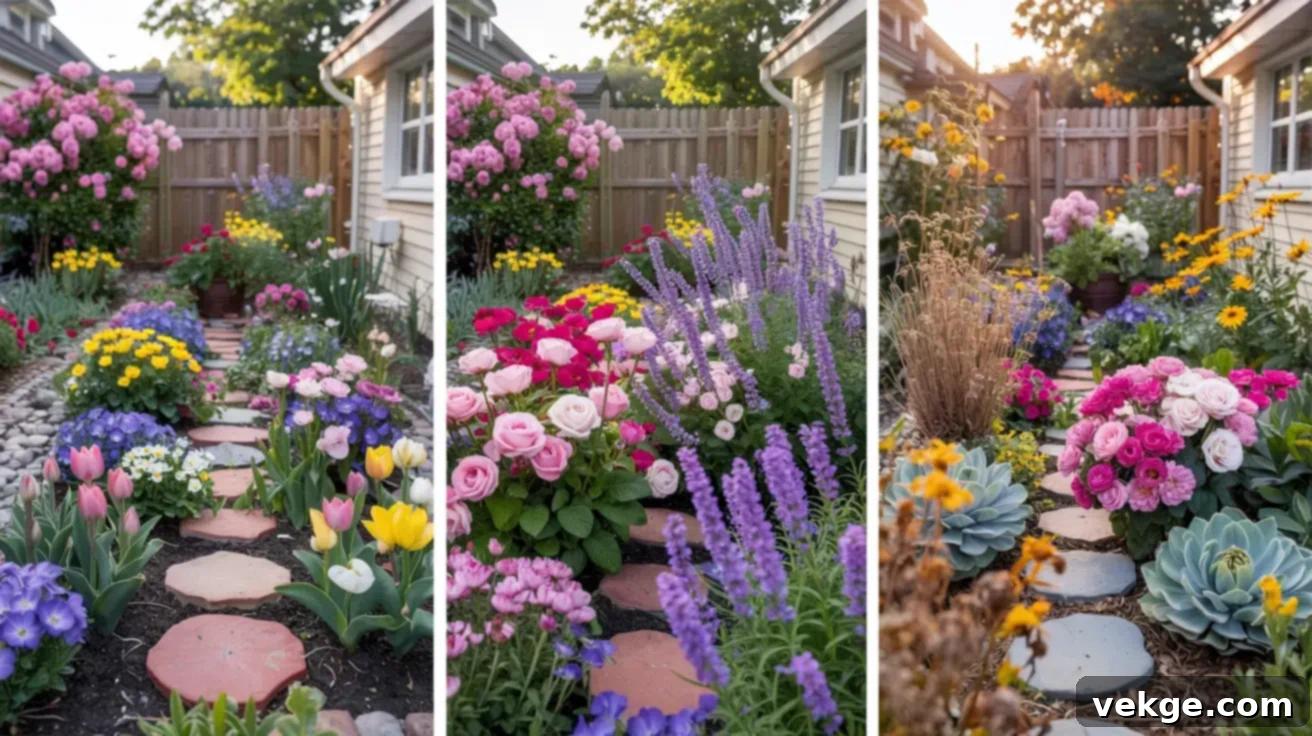
To ensure your garden remains a kaleidoscope of color and interest across all seasons, meticulously plan your plant selection based on their bloom times. For a burst of vibrant color in spring, incorporate bulbs like cheerful tulips and daffodils, along with charming primroses and delicate forget-me-nots. As summer arrives, let your garden explode with classic roses, fragrant lavender, whimsical cosmos, and sturdy coneflowers. When autumn approaches, transition to the rich hues of sedum, asters, chrysanthemums, and various ornamental grasses. By carefully mixing plants with different bloom times, you guarantee that there’s always something new and exciting happening in your garden, providing continuous visual delight. This strategy also significantly benefits local pollinators, offering a consistent food source throughout the growing season. Place early bloomers in prominent, easily visible spots, and artfully tuck later-blooming varieties behind them to ensure a seamless and natural transition as the seasons change.
Edible + Ornamental Blends: Beauty Meets Bounty
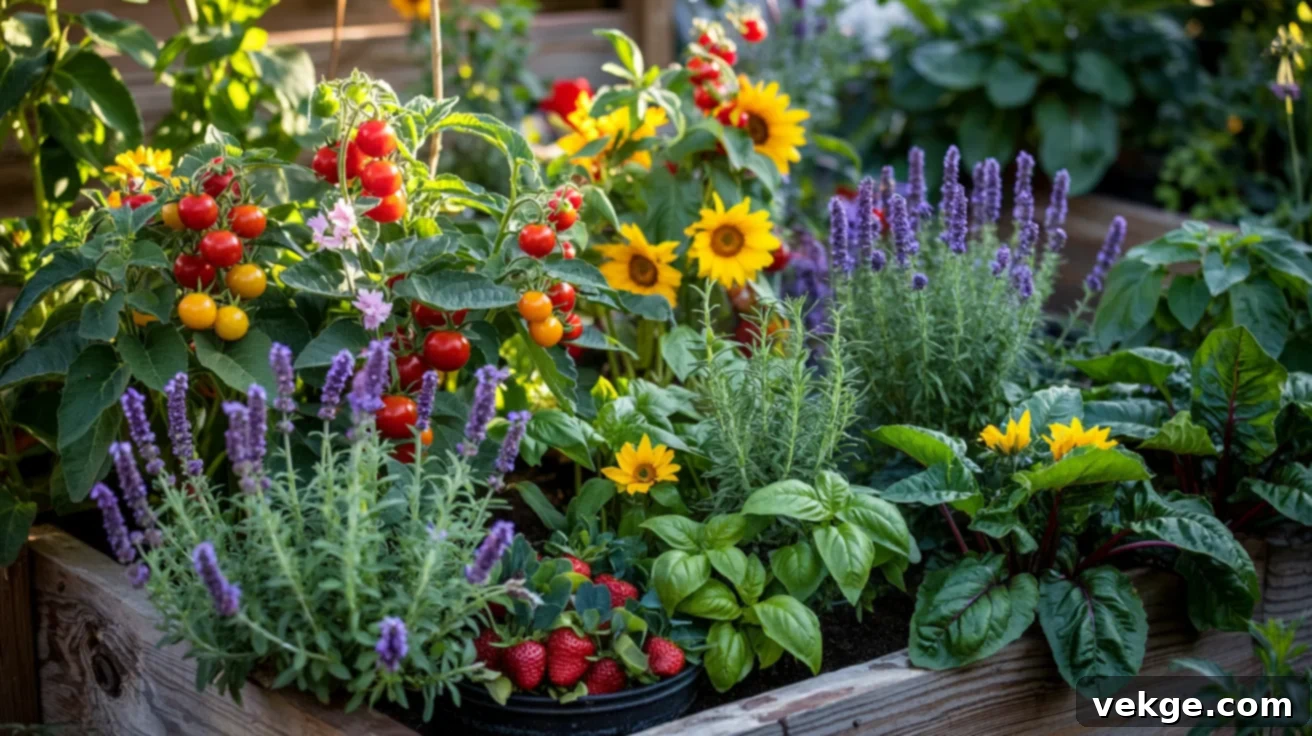
Cottage gardens inherently excel at combining aesthetic beauty with practical usefulness. Embrace this tradition by artfully tucking culinary herbs like aromatic rosemary, sweet basil, or savory thyme between your ornamental flowers. Utilize the vibrant foliage of leafy greens such as colorful Swiss chard or delicate lettuce as attractive border plants. Sweet strawberries, cheerful cherry tomatoes, and compact bush beans can also be integrated directly into your flower beds, adding delightful pops of green and red. These clever edible-ornamental blends are not only space-saving but also attract beneficial pollinators and significantly enhance the functionality and charm of your garden. Just ensure that your edible plants receive the necessary sunlight and adequate airflow they need to flourish and produce a healthy harvest.
Shade-Tolerant and Sun-Loving Options: Matching Plants to Their Environment
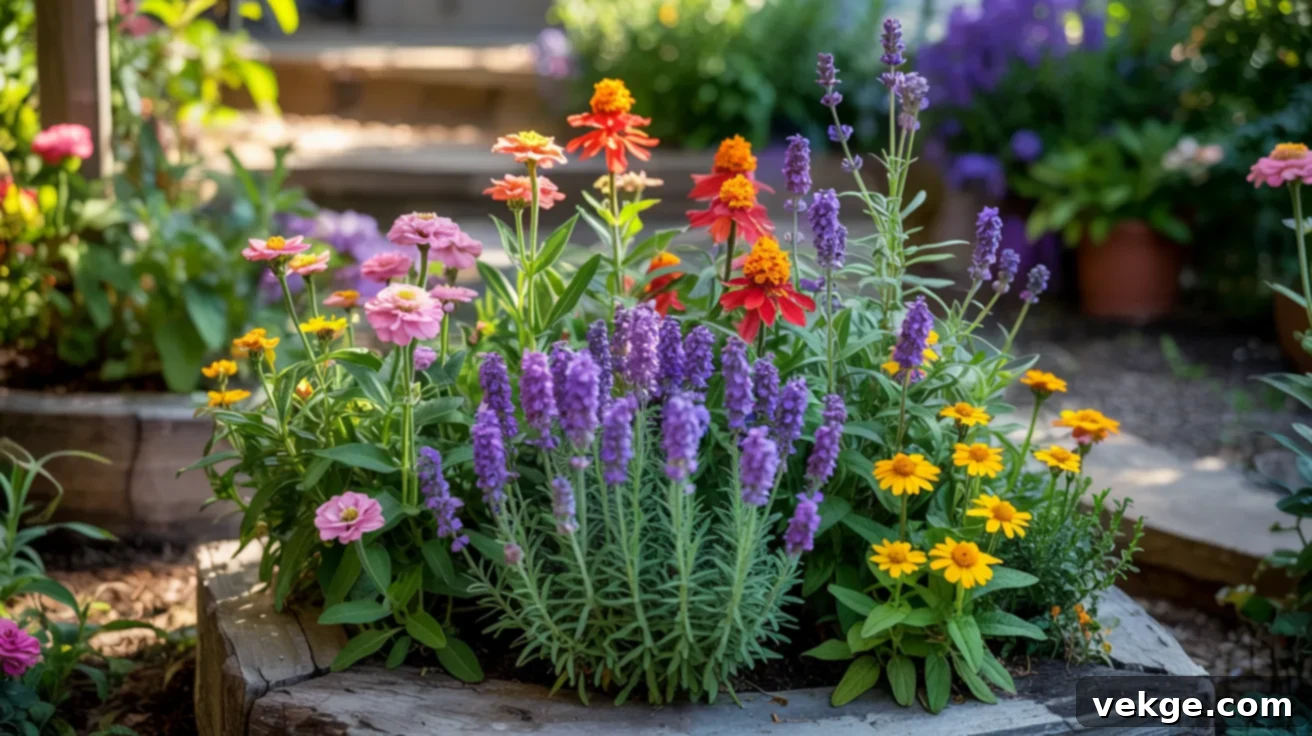
A deep understanding of your garden’s sun patterns is fundamental to placing plants where they will truly thrive. For those sun-drenched areas, select plants that bask in full light, such as fragrant lavender, vibrant salvia, cheerful yarrow, and long-blooming zinnias. Shadier spots, often found beneath trees or on the north side of structures, are ideal for shade-loving species like lush hostas, elegant astilbes, and striking foxgloves. Areas receiving partial sun—typically 4-6 hours of direct sunlight daily—can support a diverse range of plants, including delicate columbine, vibrant snapdragons, and majestic hydrangeas. Grouping plants according to their specific light requirements ensures they remain healthier, reduces stress, and minimizes the need for constant intervention. If you’re uncertain about your garden’s light conditions, dedicate a full day to tracking sunlight patterns across your yard, allowing you to precisely match each plant to its ideal location.
Common Mistakes to Avoid in Cottage Garden Design
While cottage gardens are forgiving, many common issues can be easily circumvented with a bit of foresight and attention to detail. Be mindful of these potential pitfalls:
- Planting too close together: Overcrowded plants compete fiercely for essential light, water, and nutrients, leading to stunted growth, increased disease susceptibility, and messy, unkempt beds. Always research mature plant sizes.
- Ignoring bloom times: Relying solely on plants that bloom in a single season will leave your garden looking sparse and uninteresting for many months. Thoughtfully mix spring, summer, and fall flowering varieties for continuous interest.
- Placing tall plants in front: This fundamental design error will obscure smaller plants, blocking their sunlight and making them appear lost. Always position taller specimens at the back or center of beds, layering down to shorter ones.
- Forgetting practical pathways: Pathways that are too narrow or poorly planned make it difficult to move through the garden for enjoyment or maintenance. Aim for pathways that are at least 2 to 3 feet wide for comfortable access.
- Skipping a layout plan: While a natural, free-form look is desirable, planting randomly can result in a chaotic, inefficient garden. A thoughtful layout plan, even a simple sketch, ensures your garden appears full and abundant without becoming overwhelming or disorganized.
Enhancing Your Cottage Garden with Structural Elements
Integrating simple yet effective structures can significantly elevate the interest, functionality, and comfort of your garden. These thoughtful features help organize your space, guide movement, and provide inviting spots to pause and fully appreciate your garden’s inherent beauty.
Arbors, Trellises & Pergolas: Adding Vertical Dimension
Arbors and trellises are quintessential cottage garden elements, providing essential support for climbing plants such as romantic roses, vibrant clematis, or fragrant honeysuckle. Position them strategically over garden paths to create enchanting entrances, at the end of a long vista, or near seating areas to frame a view. Larger structures like pergolas can span wider areas, offering welcome dappled shade and a sense of enclosure. While classic wood is the most common material, durable metal and low-maintenance vinyl options are also popular. These vertical structures add significant height and interest, defining distinct garden “rooms” and drawing the eye upwards without consuming valuable ground space.
Seating Areas & Relax Zones: Places for Retreat
Creating a designated quiet spot for contemplation and relaxation is vital to a truly enjoyable garden. Envision a rustic wooden bench nestled beneath the shade of a mature tree, an elegant metal chair surrounded by a profusion of blooms, or a cozy small fire pit area for evening gatherings. Enhance the invitation by adding comfortable cushions, a small side table for a cup of tea, or a soft throw. Position your seating to capture the gentle morning sun or the golden evening light, and surround it with fragrant plants like lavender, jasmine, or sweet peas to create a calming and sensory-rich environment.
Paths and Borders: Guiding Flow and Defining Space
Well-designed paths are more than just functional routes; they organize your garden space, protect your delicate plants from foot traffic, and add to the overall aesthetic. When selecting materials, consider what suits your garden’s style and local weather conditions. Gravel offers an affordable, permeable, and charming option, while classic brick lends a tidy, enduring feel. Natural mulch provides a soft underfoot experience and blends seamlessly into the garden’s organic appeal. Use attractive edging materials like natural stone, reclaimed timber, or even woven willow to clearly separate planting beds from walkways. Thoughtfully planned paths not only preserve your plants but also orchestrate the flow and experience of your entire garden, making every journey through it a delight.
Budgeting and Resourceful Shopping for Your Cottage Garden
Creating your dream cottage garden doesn’t have to break the bank. Begin by leveraging what you already possess: repurpose old containers, transform scrap wood into a charming trellis, or exchange plant cuttings and divisions with fellow gardening enthusiasts in your community. Actively seek out bundles of hardy, locally adapted plants that thrive in your specific climate zone, as these often require less ongoing care and are more resilient.
Explore local community groups, garden clubs, or online marketplaces for secondhand pots, benches, and tools, which can often be found in excellent condition for a fraction of the cost. For a truly personal touch, consider crafting your own stepping stones using simple molds and concrete—a rewarding DIY project. These small, resourceful choices allow you to build your garden incrementally, piece by piece, without the pressure of purchasing everything brand new.
For additional inspiration and structured guidance, a wealth of books and online resources offer ready-made guides. Many include detailed layout ideas, thoughtful plant pairing tips, and invaluable seasonal care charts. Look for affordable digital downloads on platforms like Amazon or Etsy. These resources can complement your personal sketches, providing a foundational structure without the expense of a professional designer. Don’t hesitate to annotate printed pages with your own notes and observations as your garden takes shape and evolves over time.
Basic Tool Checklist for Beginner Cottage Gardeners
Having the right tools makes gardening more enjoyable and efficient. Here’s a basic checklist for starting your cottage garden:
- Trowel: Indispensable for digging small holes for planting, transplanting seedlings, and breaking up soil.
- Hand Pruners (Secateurs): Essential for trimming stems, deadheading spent blooms, and shaping plants for healthy growth.
- Gardening Gloves: Protect your hands from thorns, dirt, and blisters while planting, weeding, or handling rough materials.
- Watering Can or Hose with Nozzle: Absolutely vital for providing consistent hydration to your plants, especially during dry spells.
- Hand Rake (or Cultivator): Helps loosen compacted soil, remove small weeds, and prepare beds for planting.
- Shovel (Optional for small gardens): Useful for digging larger beds, moving soil, or turning compost.
- Small Level (Optional): Handy for ensuring pathways are even or when installing edging materials.
- Wheelbarrow or Garden Cart (Optional): Makes transporting soil, compost, mulch, or tools significantly easier.
- Multipurpose Tool: Consider tools that combine functions like digging, cutting, and weeding to save space and streamline tasks.
- Storage Bin or Bucket: A simple solution for keeping all your tools organized and easily accessible for grab-and-go gardening.
Maintenance and Sustainable Practices for a Thriving Cottage Garden
A little consistent care goes a long way in ensuring your cottage garden not only survives but truly thrives. Incorporating these simple, regular habits will support healthy soil, robust plant growth, and long-term ecological balance within your garden space.
- Water Early or Late in the Day: This crucial practice minimizes water loss through evaporation, allowing plants ample time to absorb moisture without the stress of intense midday heat.
- Utilize Mulch for Moisture Retention: A generous layer of organic mulch (like wood chips, straw, or shredded leaves) helps keep soil temperatures cooler, dramatically reduces water evaporation, and effectively suppresses weed growth, saving you time and effort.
- Choose Hardy, Local Plants: Prioritize native plants or those well-adapted to your local climate. They typically require less supplemental water, exhibit natural resistance to local pests, and integrate seamlessly into the ecosystem.
- Compost Your Garden Waste: Transform fallen leaves, plant cuttings, kitchen scraps, and other organic materials into nutrient-rich compost. This natural soil amendment feeds your garden organically, improves soil structure, and significantly reduces waste.
- Rotate Seasonal Care Tasks: Establish a rhythm for your garden. In spring, focus on planting new additions and light pruning. During summer, prioritize consistent watering and deadheading spent blooms to encourage continuous flowering. In fall, clear spent annuals, compost leaves, and prepare beds for winter dormancy.
- Limit Chemical Use: Adopt natural pest control methods, such as introducing beneficial insects or practicing companion planting (e.g., marigolds deterring nematodes). This protects pollinators, wildlife, and the overall health of your garden ecosystem.
- Regularly Check for Overcrowding: Periodically thin out plants that have grown too large or too close together. This ensures adequate room for growth, prevents disease by improving air circulation, and keeps your beds looking their best.
Conclusion: Cultivating Your Personal Cottage Garden Oasis
Having explored the delightful world of cottage garden layouts, we hope you now feel inspired and empowered to embark on your own gardening adventure. You’ve gained invaluable insights into strategic planning, thoughtful plant selection, and incorporating those charming structural elements that infuse a space with personal character and warmth. Remember, the journey of creating a cottage garden is a gradual and rewarding one.
Whether you choose to begin with a small, manageable corner or dive headfirst into a full garden transformation, know that building slowly and intentionally is perfectly acceptable. The most enchanting gardens, much like life itself, grow alongside you, unfolding their beauty and offering new discoveries with each passing season. If you’re eager for more practical tips, innovative layout ideas, or simple DIY projects, a wealth of resources awaits. Continue to explore our other blogs and keep nurturing something beautiful that you’ll cherish and enjoy every single day.
